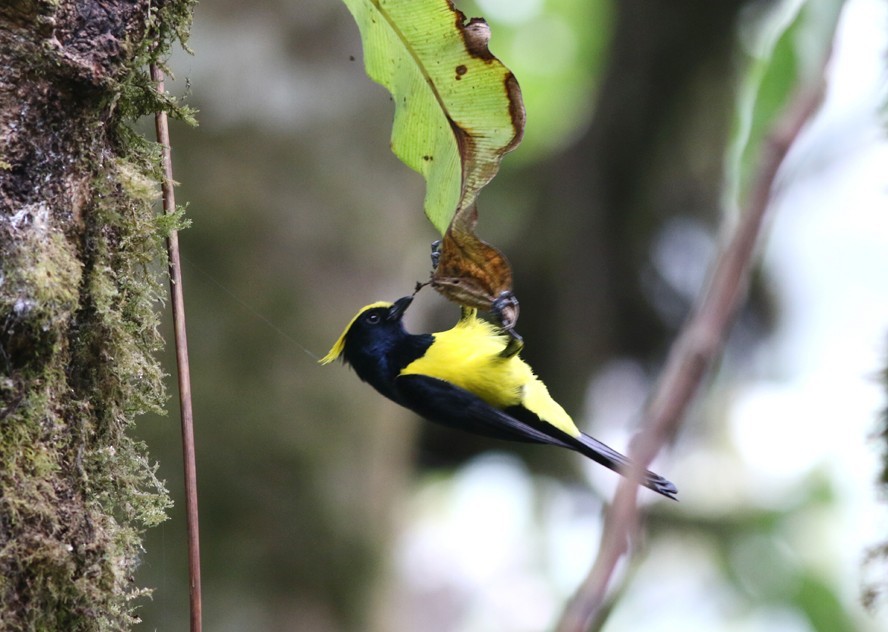Sultan Tit
A species of Sultan Tit Scientific name : Melanochlora sultanea Genus : Sultan Tit
Sultan Tit, A species of Sultan Tit
Botanical name: Melanochlora sultanea
Genus: Sultan Tit
Content
Description General Info
 Photo By Rofikul Islam
Photo By Rofikul Islam Description
The male has the forehead and crown with the crest brilliant yellow; the whole upper plumage, sides of the head and neck, chin, throat, and breast deep black glossed with green, the edges of the feathers of the upper plumage with a metallic lustre, and the outermost tail-feathers tipped with white; lower plumage from the breast downwards deep yellow, the thighs barred or mottled with white. The recumbent crest is raised when the bird is alert or alarmed. The female has the yellow parts duller; the upper plumage and sides of the head dark greenish-brown; the chin and throat glossed dark olive-green; wings and tail dull black; the feathers of the upper plumage edged with metallic green. The young resemble the female, but in the youngest stage the bright edges to the plumage of the upper parts are absent, and the greater wing-coverts are edged with white. They forage in the mid and upper canopy singly or in small groups mainly and feed mainly on insects but sometimes feed on figs. Their loud calls with short repeated and variable whistling notes have a tit-like quality. The flight is slow and fluttery. The bill is black; the mouth dark fleshy; the eyelids grey; the iris dark brown; the legs are grey; the claws dark horn. The length is about 8 inches; the tail measures 3.8 inches; the wing 4.4 inches; the tarsus 0.95 inches; the bill from the gape 0.75 inches. 
Size
21 cm
Nest Placement
Cavity
Feeding Habits
Sultan Tit primarily feed on small invertebrates like grasshoppers and spiders, and also consume fruits and seeds. They forage in pairs or groups, often in tree canopies, using acrobatic motions and occasionally capturing prey mid-flight. Unique for their somewhat lethargic and stiff movements compared to similar species.
Habitat
The sultan Tit is commonly found in the edges of lowland and submontane forests, including deciduous, mixed deciduous, and evergreen forests. It also inhabits light forests with bamboo, areas of secondary growth, scrublands, and the fringes of cultivated lands. This bird is typically associated with dense canopies and lush undergrowth in broad geographical regions characterized by such forested habitats.
Dite type
Frugivorous
General Info
Feeding Habits
Bird food type

Fruit
Distribution Area
Four subspecies are recognized with the nominate sultanea (Hodgson, 1837) found from Central Nepal into the eastern Himalayas extending into Myanmar, northern Thailand and Southern China. This intergrades with the race flavocristata (Lafresnaye, 1837) is found further south in Thailand, the Malay Peninsula and Hainan. Race seorsa is found in Laos and parts of southeastern China (Guangxi, Fujian) and in its northern range intergrades with sultanea. Subspecies gayeti named after the collector M.V. Gayet-Laroche by Delacour & Jabouille in 1925 has a black crest in both males and females and is found in Laos and Vietnam. In India, this species occurs in the lower ranges of the Himalayas from Nepal to the head of the Assam valley, the Khasi hills, Cachar, Manipur, the Kakhyen hills east of Bhamo, Arrakan, the Pegu hills, Karennee, and Tenasserim. This species does not appear to be found above 4000 feet of elevation. It extends down the Malay peninsula. It frequents the larger trees in small flocks. In some forest areas such as the Buxa Tiger Reserve, the density has been estimated at around 15 per square kilometre. The breeding season in India is April to July and the clutch is of seven eggs laid inside a lined tree cavity. They feed on caterpillars and sometimes small berries. Widely distributed within suitable habitats throughout its large range, the Sultan Tit is evaluated as Least Concern on the IUCN Red List of Threatened Species. 

 Photo By Rofikul Islam
Photo By Rofikul Islam